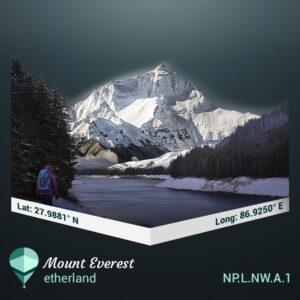 Located between Nepal and Tibet and named after British surveyor Sir George Everest, the Mount Everest stands 8,849 meters tall as the highest mountain on the planet. Even though over 300 people died on its flanks since the early expeditions of the 1920s, many climbers still challenge themselves and try to reach the summit every year.
Located between Nepal and Tibet and named after British surveyor Sir George Everest, the Mount Everest stands 8,849 meters tall as the highest mountain on the planet. Even though over 300 people died on its flanks since the early expeditions of the 1920s, many climbers still challenge themselves and try to reach the summit every year.
One thing we all have learned in school in general knowledge is that Mount Everest is the highest mountain above sea level in the world. Mount Everest is located in Nepal in the Himalayan range at the border of Nepal and Tibet (an autonomous region of China). It is known as Sagarmatha in Sanskrit and Nepali, which means “Peak of the Heaven.” Locally it is also known as Chomolungma, which means “Goddess Mother of the World” or “Goddess of the Valley.”
The fact that Mount Everest is the highest peak on Earth was discovered by a British surveyor, Sir George Everest, in 1852. Before this discovery, the mountain was known as Peak XV. With an elevation of 29,032 feet, Mount Everest attracts many climbers and mountaineers from all around the world. The first recorded person to climb to the summit came from New Zealand. Edmund Hillary and his Tibetan guide Tenzing Norgay made history in 1953.
According to the climbers, there are two main routes for climbing. The standard route takes to the summit from southeastern Nepal. This route may not be as difficult as the other route regarding climbing challenges. However, it poses extreme dangers of altitude, weather, sickness, and oxygen levels. The different way is via the North in Tibet. Among many dangers, one danger that remains common and natural is avalanches, icefalls, snowfalls, and low oxygen levels. Most climbers are not naturally accustomed to low oxygen levels and rely on oxygen tanks, the weight they have to carry during climbing. The area of the mountain above 26,000 feet is known as the “death zone”. Most climbers die here while many develop sickness and even brain swelling.
Given the harsh conditions, many people have lost their lives in the process of climbing. Many among them died an unknown death, and people behind them had no idea if they were alive or where their dead bodies might be. One of the famous and first mysteries in this respect was of George Mallory and Andrew Irvine. In 1924, they attempted to climb to the summit but never returned. It sparked a debate whether or not they were the first ones to reach the top. Not knowing the facts, historians mention their names for their effort and passion. As of 2019, over 300 people lost their lives on Everest, many of whose bodies are yet to be found.
Mountain climbing is a popular but dangerous, painstaking, and laborious adventure. This task cannot be completed without the help of a mountain guide by the local ethnic group, the Sherpa people. This group of people has valuable experience and knowledge of mountain climbing which they provide to climbers and mountaineers. As they live at such a high altitude, they are naturally accustomed to low oxygen levels. Traditionally, Sherpas are known for farming, herding, and trade.
Since climbing a mountain involves many health and death risks, the Nepalese government asks to produce an impressive mountaineering climbing experience, a good health certificate, and a trained Nepalese guide. The government also encourages learning the native language to make communication easy.
To the people who love mountains and climbing, Mount Everest is a challenge as well as a gift. The beautiful and mighty Mount Everest calls the climbers and waits to be explored.